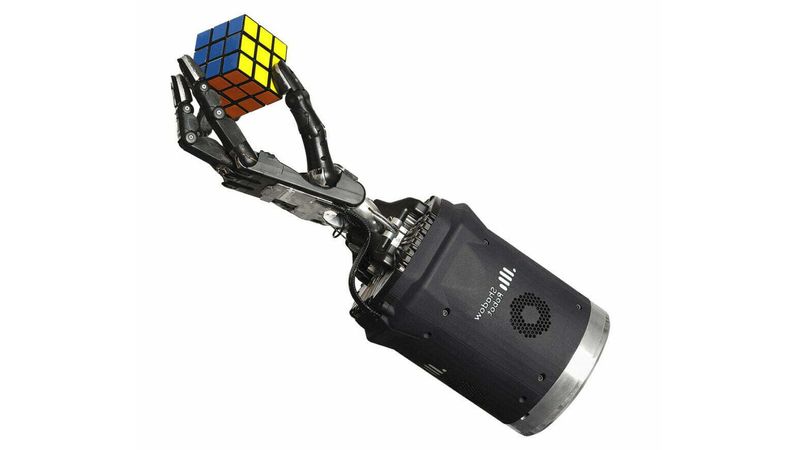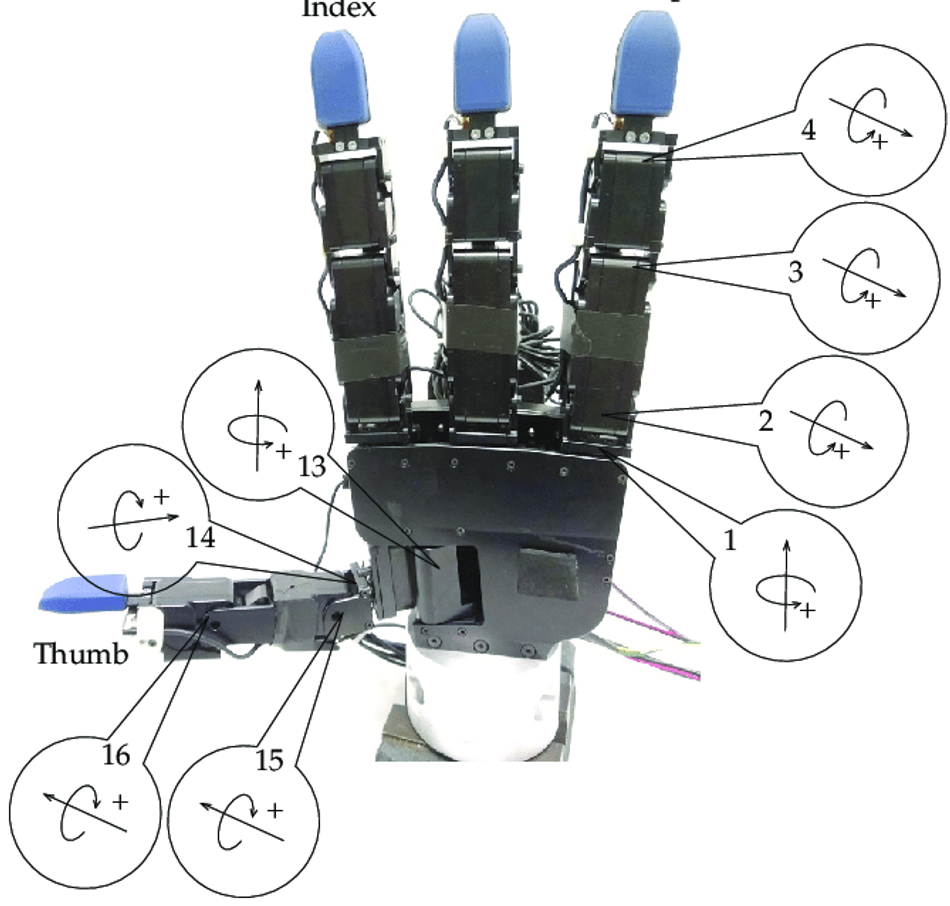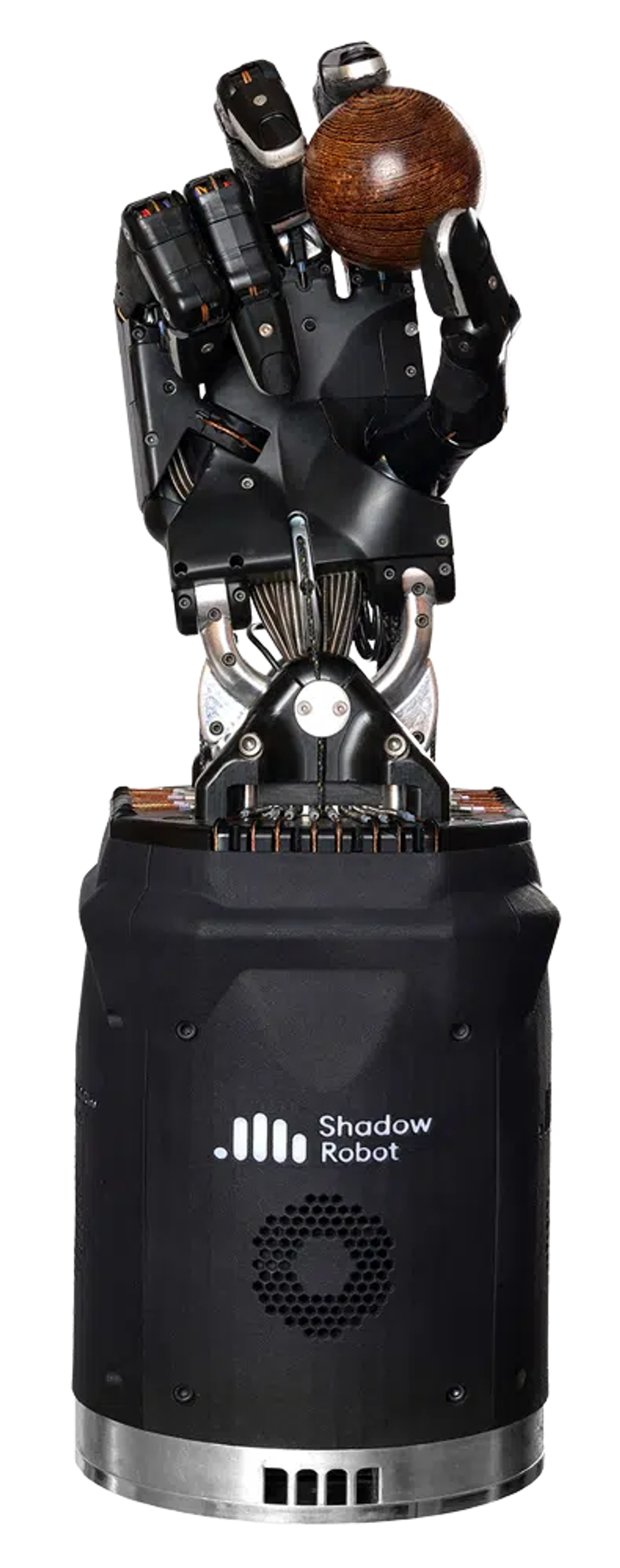Dexterous Robotic Hands Part 1: Unraveling the History, Technology, and Applications of Dexterous Robotic Hands
Agile, robust, and dexterous hands are a challenging puzzle piece to the potential of robotics.
Article 1 of a three-part series on dexterous hands. Read article two and three.
Introduction
In the evolving landscape of robotic innovation, dexterous hands stand out as a noteworthy standard for human-like robot interaction with the world. Since the early days of robotics, replicating the human hand has held fascination for researchers and enterprises alike. The technology itself captures the imagination, and also carries self-evident practical uses, with the ability to perform teleoperated tasks that require complex dexterous movement. In this article, we explore the history of dexterous robotic hands, the technologies involved, as well as ongoing research. Additionally, we discuss several practical applications for dexterous hand technology that are in use today.
At the forefront of dexterous hand innovation is the Shadow Robot Company. The company behind the Shadow Robot Dexterous Hand has paved the way for advanced haptic systems, AI-driven control, and material innovations that have created new possibilities for real solutions using human-like dexterity. This article presents the Shadow Dexterous hand as the culmination of technological advancements and dexterous hand history.
History of Dexterous Robotic Hands
Early research and development into dexterous robotic hands emerged in response to the apparent utility of robots capable of performing tasks that require fine motor skills and adaptability. The Stanford/JPL Hand, considered the first dexterous robotic hand, was developed in the early 1980s to investigate fine robotic manipulation. The Stanford/JPL Hand has three independently controlled fingers and is equipped with force feedback for more natural interaction with objects than previous industrial gripper hands. Soon after, the Utah/MIT Dextrous Hand made breakthroughs in human-like articulation, robotic dexterity, and sensing, becoming the foundation for future dexterous hand design[1]. Here is a timeline of the key milestones and breakthroughs in dexterous hand design:
- 1960–1970s – The earliest robotic hands are grippers built for industrial applications, with limited dexterity and function.
- 1980s – The Stanford/JPL Hand and Utah/MIT Dextrous Hand are among the first dexterous robotic hands, advancing research into fine motor control and robot dexterity.
- 1990s – Underactuated dexterous hands are introduced, which have fewer actuators than the number of degrees of freedom. This concept reduces the complexity of the hand and how it is controlled.
- 1997 – The first wooden iteration of the Shadow Hand is developed. A university reaches out with intent to buy the hand and the inventors seize the opportunity to build the business.
- 2000s – Advancements in materials science, power efficiency, and the miniaturization of actuators enhance the versatility of robot hands for applications like robotic prosthetic hands.
- 2004 – Shadow Robot develops the air muscle hand, which becomes the company’s flagship product.
- 2010s – The emergence of soft robotics further improves the flexibility of dexterous hands, introducing more possibilities for grasping delicate objects and safe interaction with humans.
- 2010 – The motorized Shadow Dexterous Hand is developed by the Shadow Robot Company, replacing the air muscle hand. The Shadow Dexterous Hand is a breakthrough in dexterity that closely replicates human hand movements.
- 2020s – Research and development continues to advance, incorporating artificial intelligence, machine learning, materials advancements, and haptic feedback to further improve robotic hand dexterity, adaptability, and operation. Progress on the Shadow Hand continues with cutting-edge materials, sensors, and controls.
Technologies Used in Dexterous Robotic Hands
The engineering of dexterous robotic hands has both benefited from and informed the research and development of a wide range of key technologies, including actuators, sensors, haptics, artificial intelligence, machine learning, and materials science. The sections below look at each of these areas of development as they relate to dexterous hands.
Actuators
Actuators are the components that deliver movement in the fingers, wrist, and other joints of a dexterous robotic hand. Actuator movement is directed by a teleoperated controller and by sensors on the hand itself. Various types of actuators are used in robotic hands, depending on the power, size, precision, and application.
- Pneumatic actuators – Pneumatic systems use air pressure to control the bending of the fingers and joints. These are typically constructed from metals and hard plastics.
- Soft actuators – These actuators are made from soft and flexible material and use a range of mechanisms to drive movement. Soft actuators may use air to inflate and deflate elastomeric material, while some change the shape of elastomeric material using an electric field or with temperature changes.
- Fluidic actuators – Fluidic actuators use fluid pressure to bend the joints in both rigid hydraulic actuator systems and soft actuator systems.
Actuators are also responsible for the degrees of freedom in a robotic hand, which are the number of independent axes on which a robotic hand can move. Each axis requires an actuator to bend. Actuators drive the grasping pattern and level of dexterity of the robot hand.
An important advancement for dexterous robotic hands was the development of underactuated mechanisms. Underactuated robotic hands have fewer actuators than the number of degrees of freedom. This is achieved by breaking down finger movements into modular units controlled by a single actuator, meaning that the hand can perform agile movements with reduced complexity of controls[2].
Sensors
Sensors integrate with actuators to enable a dexterous robot hand to interact with the environment and perform various tasks. Sensors gather data about the properties of an object in the environment and about the state and position of the hand itself. This data is shared with other parts of the system resulting in precise control at individual points of contact.
Data from sensors is incorporated into actuator movement for a more human-like response to an object’s weight, fragility, temperature, and other qualities. Hands with advanced sensory systems are capable of delicate and precise grasping and contact pressure sensing. Sensors also detect the position of each joint in relation to other joints and the entire hand itself, resulting in a complete system of sensing and movement that operates like a human hand.
The following are some examples of advanced sensor technology used in dexterous robotic hands:
- Soft capacitive sensors – Soft capacitive sensors are sensing nodes embedded in silicone material that is used as the skin of a robot hand. These sensors are used to detect the conductivity of objects, which provides the hand with information about the composition of the object it is interacting with[3].
- Neuromorphic sensors – Neuromorphic sensors are designed to mimic the human nervous system and adapt to the data they receive. These sensors involve a complex system of specialized electronic components and algorithms, and in robotic hands, may incorporate both vision and touch sensors.
- Piezoresistive sensors – These soft sensors measure the changing resistance of an object as force is applied. When used on a robotic hand, these sensors have been shown to improve grasping and manipulation[4].
Haptics and Touch
Sensor data can be relayed to a human operator in the form of haptic feedback. Haptics provide the operator with tactile feedback so that the operator can remotely sense the properties of an object that the robotic hand is interacting with. The operator can receive this feedback through hand-held controllers, gloves or other types of wearables. Advancements in haptic capabilities may also improve object recognition and handling for dexterous robotic hands. Some examples of haptic capabilities are:
- Vibrationfeedback – The operator’s controller or glove mimics touch by generating vibrations that the user can feel.
- Force feedback – The system applies force to the operator to simulate effort like lifting, pushing, or pulling objects.
- Tactile feedback – A system of actuators simulates the feeling of different objects, materials, and surfaces against the operator’s skin[5].
- Visual and audio feedback – With visual and audio feedback, the system displays a visual cue or plays a sound to convey data about an object instead of direct touch sensations.
- Neural feedback – Neural interfaces is an emerging area of robotics research. This method of control links the operator’s brain to robotic devices through electrical signals, potentially resulting in more precise and intuitive control and haptic feedback[6].
Artificial Intelligence and Machine Learning
Artificial intelligence and machine learning play important roles in the advancing capabilities of dexterous robotic hands. Algorithms are applied to data from sensors to improve perception and recognition of objects in the hands environment. These technologies also enhance robotic grasping and manipulation, and with machine learning algorithms, the robotic hand can learn from data and improve how it handles different objects, materials, and what to anticipate in different environments.
Artificial intelligence and machine learning algorithms are also applied to operator controls for enhanced human-robot interaction. The robotic hand can learn to recognize gestures, spoken commands, and other input, and it can provide more effective haptic feedback in return. These advancements contribute to the research and development of versatile and intuitive robotic hands.
Materials Science
Materials science is another critical area of research that influences the design, functionality, and performance of dexterous robotic hands. The choice of materials impacts the hand’s durability, performance, and adaptability. These are some key considerations of materials science in the development of robotic hands:
- Surface coatings and tactile materials – Surface coatings impact gripping capabilities and the accuracy of sensor data and haptic feedback.
- Material tolerances – Researchers must understand the properties and limitations of materials used in robotic hands, how materials work together, and how they compliment or detract from the tasks that the hand performs.
- Soft robotics – The combination of movement and material is key in the development of soft robotic hands. The choice of elastomer materials can affect the bending angle and force applied by actuators in robotic hands[7].
- Bio-inspired materials – Bio-inspired materials mimic the sense of touch with enhanced electrical properties and capacity for tactile sensing. These materials can improve the sensitivity of robotic hands, bringing them closer to human capabilities.
Applications of Dexterous Robotic Hands
Dexterous robotic hands are a valuable field of research and will continue to be because their development has significant implications across diverse industries, including manufacturing, healthcare, exploration, and more.
- Industrial automation – Dexterous robotic hands are used to automate numerous aspects of industrial manufacturing, such as the placement of goods for safe shipping and storage, pick-and-place systems that improve the speed of production, and reorienting objects for speedier assembly[8].
- Medical and healthcare – In medical fields, dexterous robotic hands are used to assist in delicate surgical procedures that require precision and accuracy. Dexterous hand technology is also employed in advanced prosthetics, improving quality of life for patients by providing tactile sensation and freedom of movement[9].
- Space exploration and hazardous environments – Dexterous robotic limbs are deployed in space exploration and hazardous environments for teleoperated object manipulation. For example, the Mars Curiosity Rover’s robotic arm maneuvers devices to analyze the planet’s soil composition, while the European Robotic Arm (ERA) on the International Space Station is built to handle variety of tasks like transferring loads into the station airlock, adding new structures to the station itself, and even transporting crew members[10 , 11].
- Entertainment and gaming – Dexterous hand technology is also employed in gaming and entertainment. In particular, haptic gloves can be used to control and receive feedback from telepresence robots or virtual environments for an immersive user experience[12].
Case Study: Shadow Robot Company
Today, one of the most notable contributors to dexterous robotic hand research and development is the Shadow Robot Company. Shadow Robot aims to create custom advanced dexterous robotic systems that solve real problems and provide meaningful scientific advancement. The company’s “robots for good” policy guides the direction of innovation and partnerships, with a firm stance to never sell technology for military use.
The Shadow Robot Company began with a post on an internet hobbyist forum in 1997. The first hand was a wooden model, and the post caught the attention of a university. Around 2004, the company introduced the next generation of the hand with air muscles—the company’s flagship product until about 2010, when the Shadow Dexterous Hand introduced internal motors instead of air muscles. Since then, the hand has undergone countless improvements that build on the motorized concept.
The innovations at Shadow Robot have been put to practical use in a range of industries including research, health and medicine, space exploration, manufacturing, and entertainment. The company offers a range of dexterous hand products. Their current flagship Shadow Dexterous Hand has 20 degrees of freedom across 24 joints, and is equipped with 129 sensors and 20 DC motors for remarkable dexterity and precision.
The Shadow Hand has been used by organizations like Open AI to explore machine learning and dexterity, while its teloperated system has the potential to improve safety and efficiency for workers in hazardous settings. The hand can be controlled with a haptic glove for intuitive operation and real-time control. The company has also developed technology to perform intricate tasks in sterile environments, like the manufacture of vaccines and pharmaceuticals. Shadow Robot continues to advance dexterous hand technology with effective innovations that solve practical problems.
Conclusion
The applications and science of dexterous robotic hands continue to inspire both innovation and imagination. From precise surgical procedures to harsh and hazardous environments, the capabilities of dexterous robotic hands open new possibilities for industries as well as scientific fields. The field of robotics has greatly benefited from dexterous hand innovation, which has led to the development of underactuated technology, sensors that can detect increasingly subtle properties, haptics with human-like response, as well as the exploration of artificial intelligence as it relates to dexterity.
The Shadow Robot Dexterous Hand, a benchmark in this field, has pushed the limits further with cutting-edge technologies and applications that redefine robotic capabilities. Part 2 of this series will present a deep-dive into the dexterous hand series from Shadow Robot, and Part 3 will introduce dexterous hand and glove technology, and the lightweight Shadow Glove.
Learn more about Shadow Robot here.
References
[1] Chunmiao Yu and Pen Wang “Dexterous Manipulation for Multi-Fingered Robotic Hands with Reinforcement Learning: A Review”. Front Neurobot (2022). Accessed from https://www.ncbi.nlm.nih.gov/pmc/articles/PMC9083362/
[2] Zey Ren, et al. “HERI II: A Robust and Flexible Robotic Hand based on Modular Finger design and Under Actuation Principles”. IEEE (2018). Accessed from https://eprints.whiterose.ac.uk/144459/1/IROS_2018_errata.pdf
[3] Mahmoud Tavakoli, et al. “Autonomous Selection of Closing Posture of a Robotic Hand Through Embodied Soft Matter Capacitive Sensors”. IEEE (2017). Accessd from https://ieeexplore.ieee.org/document/7981325
[4] Ilker S. Bayer. “MEMS-Based Tactile Sensors: Materials, Processes and Applications in Robotics”. Micromachines (2022). Accessed from https://www.ncbi.nlm.nih.gov/pmc/articles/PMC9782357/
[5] Vladimír Hain, et al. “How to Use Haptic Technology in Interactive Digital Documentation of Heritage”. Haptic Technology (2022). Accessed from https://www.intechopen.com/chapters/80216
[6] Loredana Zollo, et al. “Restoring Tactile sensations via neural interfaces for real-time force-and-slippage closed-loop control of bionic hands”. Science Robotics (2019). Accessed from https://www.science.org/doi/10.1126/scirobotics.aau9924
[7] Shayni Fernando, “Collaborative Crafting of Interlocking Structures in Stereotomic Practice”. Blucher Design Proceedings (2019). Accessed from https://www.semanticscholar.org/paper/Collaborative-Crafting-of-Interlocking-Structures-Fernando/15d59e167194a042951b5984405b5ff31eb6b8f7
[8] Intel. “Industrial Robotic Arms: Changing How Work Gets Done”. Accessed from https://www.intel.com/content/www/us/en/robotics/robotic-arm.html
[9] TriHealth. “The Future of Medicine: Bionic Limbs and Robotic Surgery”. Accessed from https://www.trihealth.com/dailyhealthwire/living-well/in-the-news/the-future-of-medicine--bionic-limbs-and-robotic-surgery
[10] NASA. “Mars Curiosity Rover: Robotic Arm”. Accessed from https://mars.nasa.gov/msl/spacecraft/rover/arm/
[11] The European Space Agency. “European Robotic Arm”. Accessed from https://www.esa.int/Science_Exploration/Human_and_Robotic_Exploration/International_Space_Station/European_Robotic_Arm
[12] Adam Savage’s Tested. “Using Haptic Gloves to Control an Amazing Telepresence Robot!” YouTube (2021). Accessed from https://www.youtube.com/watch?v=rWHk4ht-boM




